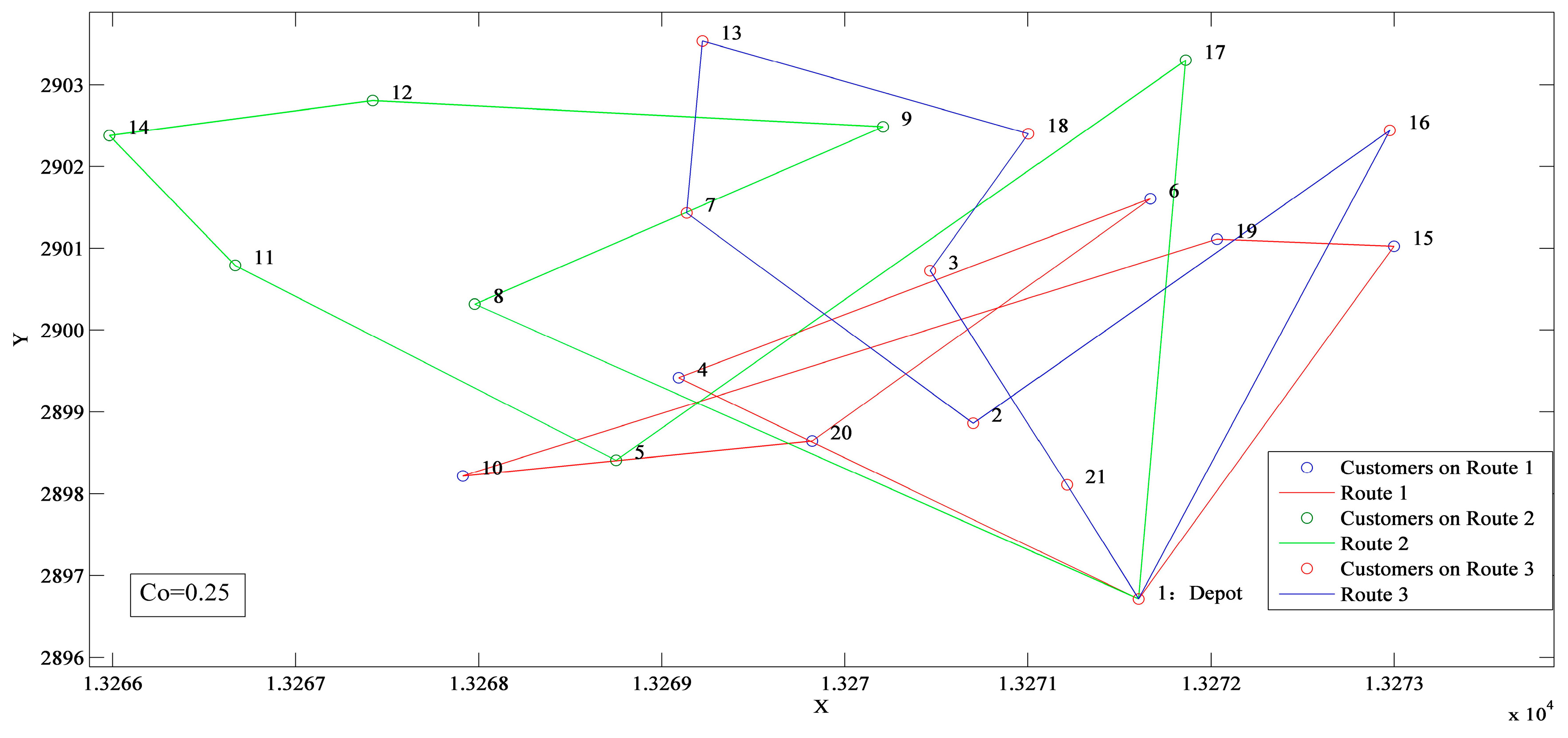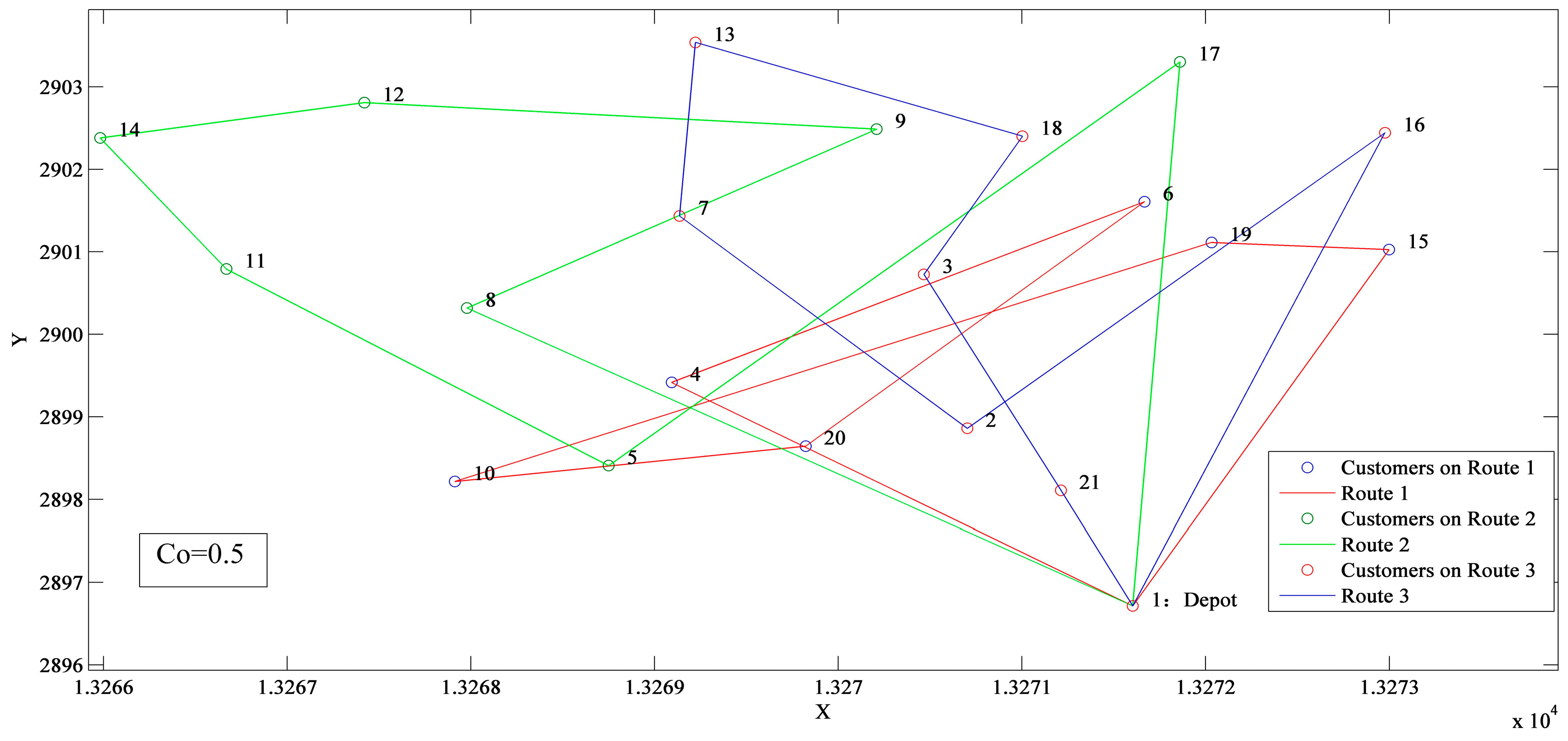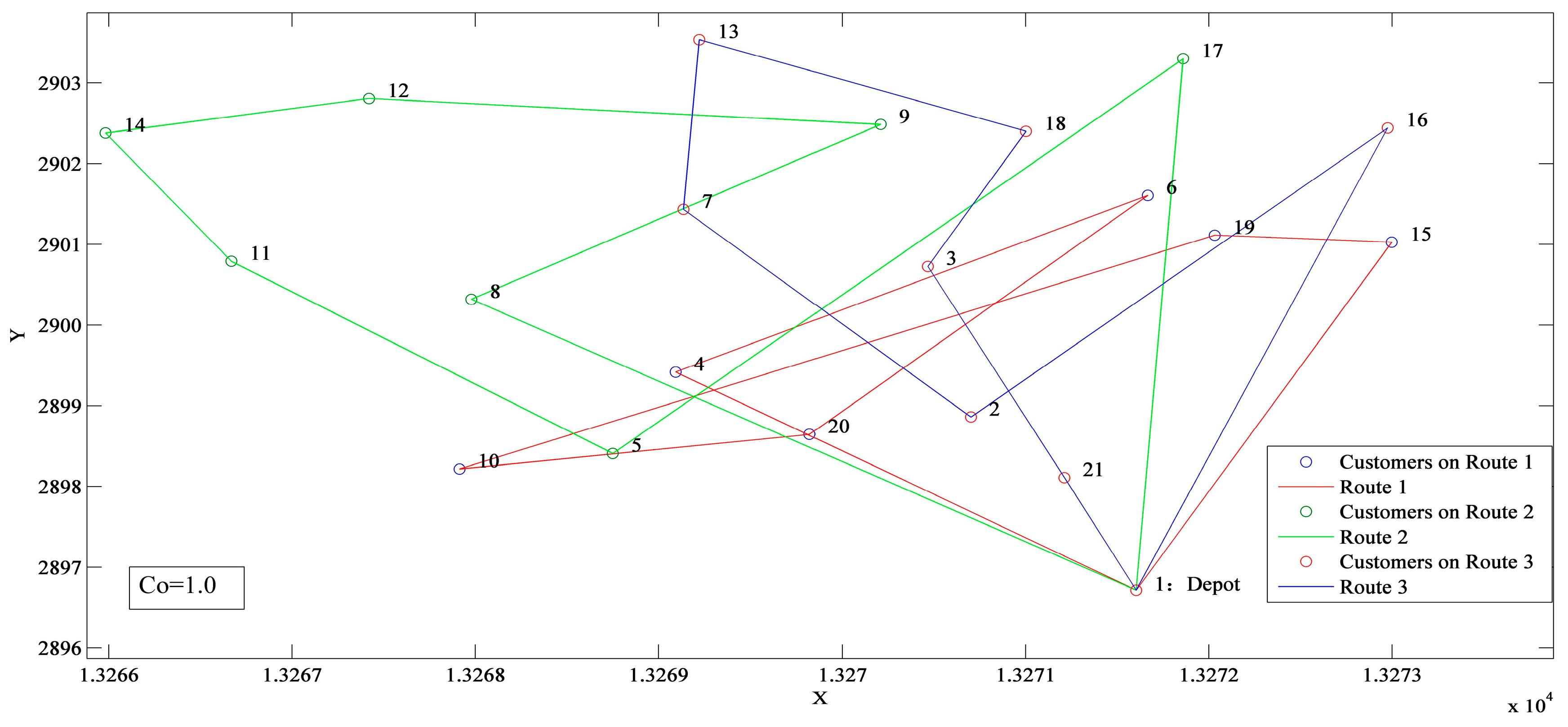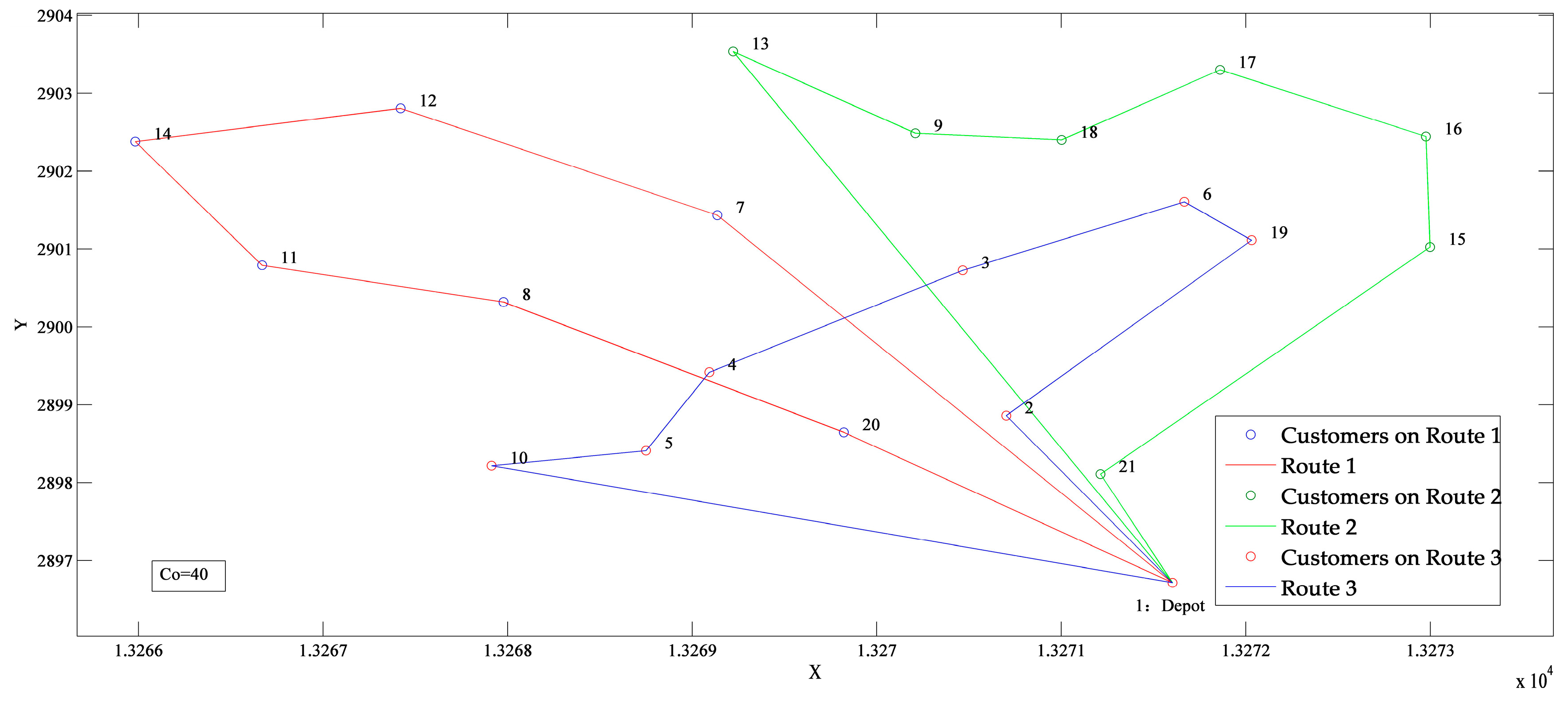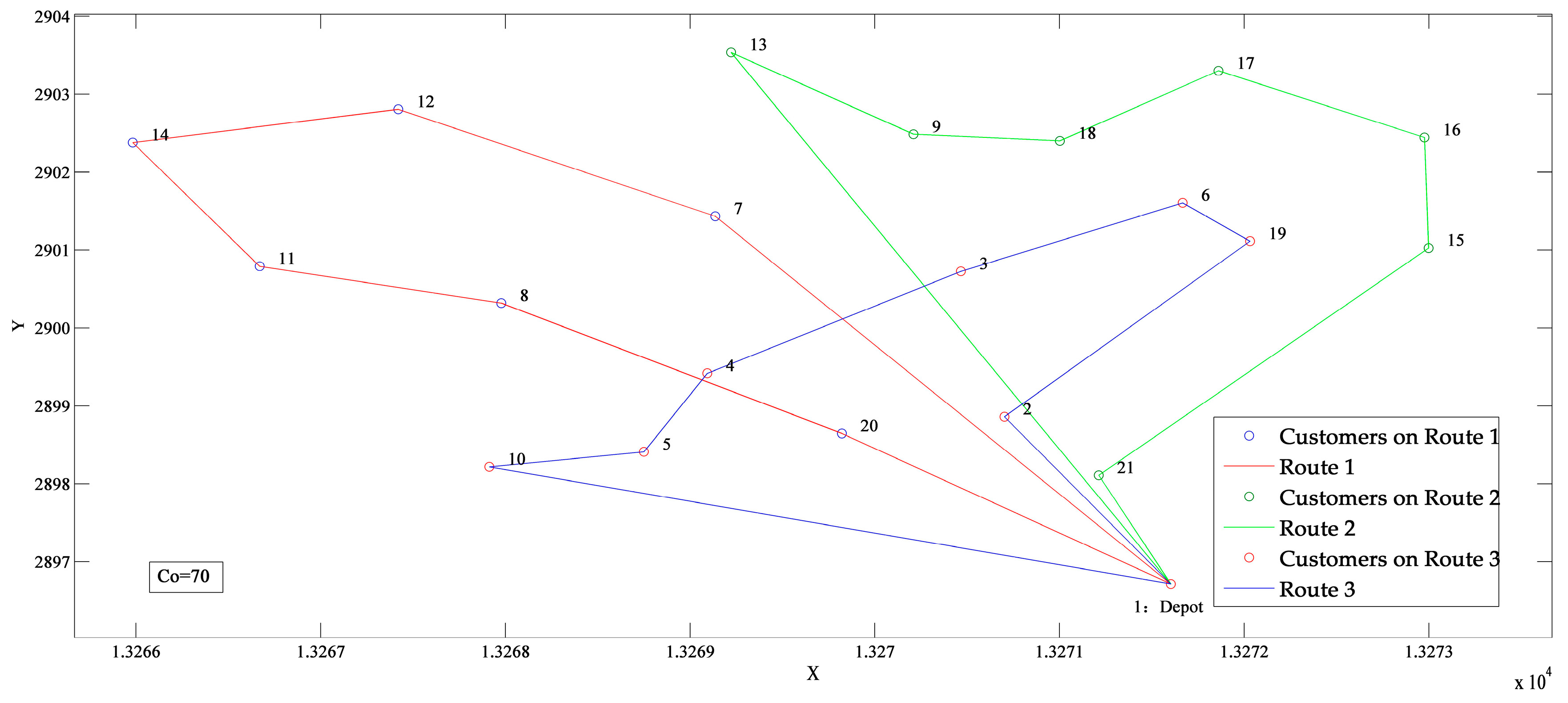The cold chain logistics VRP in this paper belongs to a type of vehicle routing problem. The VRP model of cold chain logistics considering carbon footprint is proposed to realize the path selection of low-carbon distribution. Carbon emissions in the process of cold chain distribution generate from the vehicles fuel consumption as well as from refrigeration equipment. If we only put the minimum carbon emissions as the optimization goal, it is pointless for logistics enterprises. Therefore, the objective function is not to minimize the carbon emissions or fuel consumption, but to use comprehensive cost minimum as objective function when we establish the mathematical model.
The costs of optimization mainly include: the fixed costs which generate in distribution process of vehicle, transportation costs, damage costs in the process of distribution, refrigeration costs, penalty costs, shortage costs and carbon emission costs.
2.4.1. The Optimization Goal Setting
(1) The fixed costs of vehicles
When dispatching each refrigerated truck to carry out the distribution task, some fixed costs need to be paid, including the cost of buying or renting refrigerated trucks, the driver’s wages, refrigerated trucks fixed losses and so on. The fixed costs of using a vehicle are usually constant which mainly refers to the fixed cost of vehicles with delivery tasks, except idle vehicles. Additionally, it is not related to the vehicle mileage and the number of customers.
Assuming that the depot has a total number of
m delivery routes, that is,
m refrigerated trucks will be required to provide distribution services for
n customer nodes,
represents the fixed costs of vehicle
k. The fixed costs
can be expressed as:
(2) Transportation costs of vehicles
This section considers only transportation costs; the cost of refrigeration in transit will be analyzed separately in the following. In view of the present situation of urban and rural cold chain logistics distribution in China [
27], the transportation costs of vehicles are influenced by fuel consumption, maintenance and other factors, and it is proportional to the vehicle mileage. The transportation costs
of the refrigerated vehicle can be expressed as:
(3) The damage costs
Different from the ordinary VRP, cold chain VRP transport products are perishable goods. The general VRP model considers the damage of goods during loading and unloading, which may be due to the loss caused by collision. However, this paper considers that the damage costs of perishable products are mainly due to changes in temperature during the transport and handling of the goods. There is a characteristic of perishable in refrigerated goods, so the temperature, humidity, concentration of oxygen in storage environment, moisture content in the product and other factors will affect the change of quality. The quality of perishable goods will gradually decline or even lose its value with the extension of time and temperature changes. When the quality of the product declines to a certain extent, there will be damage costs. The amount of remaining goods in refrigerated trucks is not only closely related to the demand of customers, but also directly related to the loss of the goods in the process of cold chain logistics distribution [
23].
In this paper, we introduce the variable function of refrigerated goods quality [
28]:
where
is the quality of the product at time
t;
t is the transportation time of the product;
is the quality of the product from the depot; and
is the spoilage rate of the product, its value is related to the characteristics of fresh agricultural products and temperature. It is assumed that in the process of transportation the temperature of product environment is invariable, so the spoilage rate of fresh agricultural products can be considered as a constant in an invariable temperature, the quality of fresh agricultural products with time showing characteristics of exponential change. For the same kind of products, the higher storage temperature then the spoilage rate will be larger if other factors remain unchanged. The value of
is an increasing function of temperature, i.e. it increases with temperature.
Hence, when the vehicle is starting from the depot to the customer
i and the door is not opened in the process of transportation, the damage costs
can be expressed as:
where
P is the unit price of the distribution products;
is the demand of customer
i;
represents the time point when the refrigerated vehicle
k reaches the customer
i;
represents the departure time of the vehicle
k from the depot;
indicates the spoilage rate of the product at a particular temperature during the transport process; and
is a 0–1 variable,
if the vehicle
k services for customer
i, otherwise
.
When the door is opened, due to the convection of air, the temperature inside the vehicle will rise, and the spoilage rate of fresh agricultural products will change accordingly. The hypothesis of this spoilage rate is
(
), when the vehicle arrives at the customer
i, the damage costs
generated by opening door in the process of unloading can be defined as:
where
represents the number of products remaining on board when the refrigerated vehicle leaves customer
i; and
is the time required for a refrigerated vehicle to serve customer
i.
Therefore, we can get the total damage costs in the entire distribution process.
is the sum of
and
.
(4) The refrigeration costs
Different from ordinary VRP, the refrigeration costs should be considered in the transportation of cold chain VRP model. Because of the difference of refrigeration mode, refrigerated vehicles are divided into three types: mechanical refrigeration, cold storage plate cooling and liquefied gas refrigeration. Presently, refrigerated vehicles of mechanical refrigeration are the main refrigerated vehicles in China [
29]. Refrigeration costs include the cost caused by energy consumption of the vehicle in order to keep the low temperature during delivery, as well as the cost of additional energy supplied by the refrigeration system during the unloading process.
Thus, in the process of transportation, vehicle refrigeration costs
as follows:
During the unloading process, the refrigeration costs of refrigerated vehicles
as follows:
Thus, the total refrigeration costs are
:
where
represents the waiting time of refrigerated vehicle
k for non-unloading when servicing customer
j.
(5) The penalty costs
In the distribution, customers generally have a time limit for the distribution of chilled or refrigerated foods. If the goods do not reach the destination within the time period agreed by the customer, it will affect customer satisfaction, increase vehicle energy consumption, bring goods loss costs and so on, and then produce the corresponding penalty costs. Thus, the concept of time window and Vehicle Routing Problem with Time Windows (VRPTW) are introduced. The time window is divided into hard time window and soft time window. In this paper, combining the actual situation of China’s urban and rural distribution [
30], we choose to calculate the penalty costs of soft time window
as follows:
where
represents the time of arriving in advance when the vehicle
k services customer
i; and
represents the late time of the vehicle
k services customer
i.
(6) The shortage costs
Many uncertain factors (similar to the loading and unloading cargo damage, etc.) cause the actual total demand of customers over the actual load of refrigerated vehicle in the distribution process, which will lead to customer needs unable to be met, and then producing shortage costs. Meanwhile, the quality of service will also be affected.
The shortage costs
in the distribution process can be expressed as:
(7) The carbon emission costs
As mentioned above, the refrigeration method used in Chinese refrigeration vehicles is mainly mechanical refrigeration. The energy consumption of mechanical refrigeration also affects the amount of CO
2 emissions. After a comprehensive study of the literature [
31,
32,
33,
34], the carbon emissions in the cold chain distribution process mainly include two aspects: the generation of fuel consumption and the energy consumption of refrigeration equipment.
For the amount of CO
2 emissions from fuel consumption in the distribution process, this paper uses the formula to express:
Carbon emissions = fuel consumption × CO2 emission coefficient [
35]. This part of the fuel consumption is not only related to the transport distance, but also influenced by the vehicle load capacity and other factors. Some scholars have collected relevant statistical data for regression analysis to get the fuel consumption
in unit distance can be expressed as a linear function that depends on the number of goods carried by vehicle
X [
36]. As a result, if the total vehicle weight is divided into vehicle weight
and the number of goods carried by vehicle
X, the unit distance fuel consumption can be expressed as:
It is assumed that the maximum load capacity of the vehicle is
, the fuel consumption of per unit distance at full load is
, and the fuel consumption of per unit distance is
when vehicle is empty. From the above equation,
and
can be, respectively, calculated as follows:
Thus,
can be expressed as:
Thus, the unit distance fuel consumption
can be expressed as:
Therefore, the carbon emissions
generated when the vehicle travels between customer
i and customer
j can be expressed as:
where
is the load capacity of the refrigerated vehicle when it travels between customer
i and customer
j;
represents the unit distance fuel consumption when the number of goods carried by the vehicle is
; and
is the coefficient value of CO
2 emission.
The CO
2 emissions generated by the refrigeration equipment in the distribution process are also related to the transportation distance and the amount of cargo carried. If cargo
is transported from the customer
i and customer
j, the carbon emissions
generated due to refrigeration when the vehicle travels between customer
i and customer
j can be expressed as:
where
represents the carbon emissions that generate from distributing unit weight cargoes during driving unit distance
.
The distribution vehicle is empty in the process of returning to depot when it completes the distribution task for all customers, so the refrigeration is not needed at this time, and there are no carbon emissions generated by refrigeration. The source of carbon emissions is only vehicle fuel consumption in the process of returning to depot, and can be expressed as according to Equation (16).
Thus, the CO
2 emissions generated during the entire distribution process are as follows:
This paper introduces carbon tax mechanism to calculate carbon emission costs, that is
carbon emission costs = carbon tax × carbon emission. If the carbon tax is
, the total carbon emission costs
in distribution process can be expressed as:






